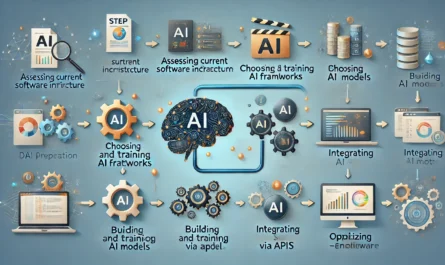In today’s competitive market, customer retention has become more critical than ever. While attracting new customers is essential, retaining existing ones is far more cost-effective and leads to sustainable growth. One of the most powerful tools available to companies looking to improve customer retention is data analytics. By understanding how to harness the power of data, businesses can transform their customer retention strategies, making them more efficient, personalized, and predictive.
The Importance of Customer Retention
Customer retention is the cornerstone of long-term business success. Research shows that increasing retention rates by just 5% can boost profits by 25% to 95%. Retaining customers leads to repeat purchases, brand loyalty, and long-term advocacy. Moreover, it is significantly less expensive to retain an existing customer than to acquire a new one, making retention efforts a smart investment for businesses of all sizes.
How Data Analytics Revolutionizes Retention Strategies
Data analytics has changed the way businesses approach customer retention. Instead of relying on intuition or outdated customer reports, companies can now use real-time data to make informed decisions. Data analytics allows businesses to track customer behavior, understand preferences, and predict future actions. This means companies can identify potential churn risks before they happen and intervene with personalized solutions.
Why Customer Retention Matters More than Acquisition
While acquiring new customers is important for growth, the true value lies in customer retention. It is well-documented that retaining customers is far more cost-efficient than acquiring new ones. Acquiring a new customer can cost five to seven times more than keeping an existing one. In addition to cost savings, retained customers often spend more over time, creating a higher customer lifetime value (CLV). Furthermore, loyal customers tend to become brand advocates, spreading positive word-of-mouth and attracting new customers organically.
What is Data Analytics in the Context of Retention?
Data analytics refers to the process of collecting, analyzing, and interpreting vast amounts of customer data to derive actionable insights. In the context of retention, data analytics helps businesses identify trends, patterns, and behaviors that influence customer loyalty. Types of data commonly used in retention strategies include transaction history, customer feedback, product usage data, and engagement metrics.
The Role of Data Analytics in Identifying Customer Behavior Patterns
One of the key benefits of using data analytics for retention is its ability to uncover customer behavior patterns. By analyzing historical data, businesses can identify what triggers customer loyalty and what leads to churn. Predictive analytics can forecast which customers are at risk of leaving and suggest targeted actions to prevent churn. By understanding these patterns, companies can create proactive retention strategies that keep customers engaged.
Key Metrics to Measure for Customer Retention
Successful customer retention strategies are built on a foundation of measurable data. Three key metrics play a crucial role:
- Customer Lifetime Value (CLV): This metric measures the total value a customer brings to a business over their entire relationship. Maximizing CLV is a primary goal of retention strategies.
- Churn Rate: Churn rate calculates the percentage of customers who stop using a service during a specific period. Lowering churn is a direct indicator of improved retention.
- Net Promoter Score (NPS): NPS gauges customer satisfaction and loyalty by asking how likely customers are to recommend your business to others.
Tracking these metrics helps businesses understand the effectiveness of their retention efforts and adjust strategies accordingly.
Segmentation and Personalization Based on Data Insights
Segmentation is a powerful tactic enabled by data analytics. By dividing customers into specific groups based on behavior, preferences, or demographics, businesses can tailor personalized marketing efforts that resonate with individual needs. Personalization improves customer experience, leading to higher retention rates. For example, a business might use purchase history data to recommend products, or target specific customers with personalized promotions that align with their preferences.
Predictive Analytics to Anticipate Customer Needs
Predictive analytics takes data analysis a step further by forecasting future customer behavior. With predictive models, businesses can anticipate which customers are likely to churn and why. This allows for preemptive action, such as offering discounts or addressing concerns before a customer decides to leave. Predictive analytics also helps in identifying opportunities for upselling and cross-selling, further enhancing customer loyalty.
Customer Journey Mapping with Data Analytics
Customer journey mapping is a strategic approach that involves tracking the steps customers take when interacting with your business. With the help of data analytics, companies can create a comprehensive view of the customer journey, from initial contact to post-purchase engagement. By analyzing data from each touchpoint, businesses can identify pain points, optimize the experience, and increase satisfaction, ultimately leading to higher retention.
Churn Analysis: Using Data to Understand Why Customers Leave
Churn analysis is the process of identifying why customers stop doing business with you. Data-driven churn analysis allows businesses to recognize patterns that lead to customer dissatisfaction. These might include slow response times, unresolved issues, or product shortcomings. By understanding the root causes of churn, businesses can make improvements that directly address customer concerns and reduce the likelihood of future churn.
Utilizing Sentiment Analysis for Improved Customer Interaction
Sentiment analysis is a technique that uses artificial intelligence (AI) and machine learning (ML) to analyze customer feedback, such as reviews or social media posts, to determine their emotional tone. This allows businesses to gauge how customers feel about their products or services in real-time. By responding to customer sentiment—whether positive or negative—companies can improve interactions, resolve issues quickly, and foster stronger relationships.
You can also read; How to Align Your Business Strategy with Market Trends
Data-Driven Customer Feedback and Satisfaction Surveys
Data analytics can transform traditional customer feedback into powerful insights. By analyzing feedback from surveys, online reviews, and customer support interactions, businesses can uncover trends that influence satisfaction and retention. Moreover, feedback can be used to segment customers into promoters, passives, and detractors, allowing for targeted retention strategies based on their level of satisfaction.
Incorporating data analytics into your customer retention efforts isn’t just about improving the bottom line—it’s about building meaningful relationships that lead to long-term loyalty. With the ability to predict behavior, personalize interactions, and identify pain points, data analytics provides businesses with the tools they need to keep customers happy and engaged for the long haul.



